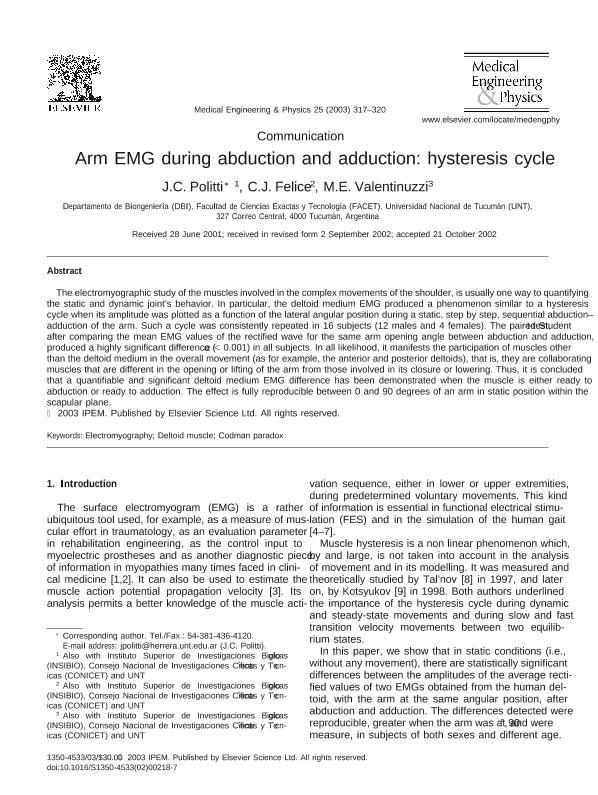Artículo
Arm EMG during abduction and adduction: Hysteresis cycle
Fecha de publicación:
02/2003
Editorial:
Elsevier
Revista:
Medical Engineering & Physics
ISSN:
1350-4533
Idioma:
Inglés
Tipo de recurso:
Artículo publicado
Clasificación temática:
Resumen
The electromyographic study of the muscles involved in the complex movements of the shoulder, is usually one way to quantifying the static and dynamic joint's behavior. In particular, the deltoid medium EMG produced a phenomenon similar to a hysteresis cycle when its amplitude was plotted as a function of the lateral angular position during a static, step by step, sequential abduction-adduction of the arm. Such a cycle was consistently repeated in 16 subjects (12 males and 4 females). The paired Student t-test, after comparing the mean EMG values of the rectified wave for the same arm opening angle between abduction and adduction, produced a highly significant difference (α<0.001) in all subjects. In all likelihood, it manifests the participation of muscles other than the deltoid medium in the overall movement (as for example, the anterior and posterior deltoids), that is, they are collaborating muscles that are different in the opening or lifting of the arm from those involved in its closure or lowering. Thus, it is concluded that a quantifiable and significant deltoid medium EMG difference has been demonstrated when the muscle is either ready to abduction or ready to adduction. The effect is fully reproducible between 0 and 90 degrees of an arm in static position within the scapular plane.
Palabras clave:
CODMAN PARADOX
,
DELTOID MUSCLE
,
ELECTROMYOGRAPHY
Archivos asociados
Licencia
Identificadores
Colecciones
Articulos(INSIBIO)
Articulos de INST.SUP.DE INVEST.BIOLOGICAS
Articulos de INST.SUP.DE INVEST.BIOLOGICAS
Citación
Politti, Julio César; Felice, Carmelo Jose; Valentinuzzi, Maximo; Arm EMG during abduction and adduction: Hysteresis cycle; Elsevier; Medical Engineering & Physics; 25; 4; 2-2003; 317-320
Compartir
Altmétricas




